Skystrider Technical Breakdown and Postmortem
Project Introduction
Skystrider is the culmination of nearly two years of collective effort, where I had the privilege of serving as the tech lead and contributing to the overall game design. Collaborating with an exceptional team, I brought my technical expertise to the table, playing a vital role in crafting an immersive and captivating experience for players. Set in a beautifully ruined world, Skystrider is a 3D third-person action platformer that invites players to traverse ethereal paths amidst clouds and tides, forging a path towards a new future.
Section Navigation
Overview
About The Game and Story
Skystrider, an exhilarating action-adventure game that takes you on a breathtaking journey through a beautifully ruined world. As the enigmatic hero, recently resurrected and entwined in a divine contract, your fate is intertwined with the towering structure on the horizon.
Harness the power of ancient technology, strewn across the desolate landscape, as you embark on an epic quest towards an unknown destiny. Explore ethereal paths amidst the ethereal clouds and turbulent tides, revealing secrets and unlocking the mysteries of this mesmerizing realm.
With stunning visuals, immersive gameplay, and a captivating storyline, Skystrider offers an unforgettable experience. Unleash your courage, uncover hidden relics, and master ancient techniques to forge your path towards a brighter future.
Features:
Experience exhilarating parkour mechanics, pushing your skills to the limit as you navigate treacherous landscapes.
Engage in deep combat systems, where precision and timing are key to overcoming formidable adversaries.
Immerse yourself in fast-paced gameplay that keeps you on the edge of your seat, with thrilling action sequences and heart-pounding encounters.
Prepare for cinematic boss fights that will test your mettle, requiring cunning strategies and quick reflexes to emerge victorious.
Put your problem-solving skills to the test with intricate puzzles scattered throughout the world, unraveling ancient enigmas and unlocking hidden secrets.
Embark on an extraordinary adventure as the sky becomes your domain and destiny awaits. Will you rise and bring hope to this shattered world? Prepare to ascend beyond your limits and soar towards an uncertain yet promising future.
Story Concepts
The Tower
The Tower stands over everything in the game, a guiding beacon to the player as they traverse worlds they’re unfamiliar with. It’s a staple of the game’s narrative. Most of the shape language in the game traces back to the design of the tower making use of curves that terminate in straight lines. Because the Tower is also a force of unknown technology, it made sense to incorporate some organic elements with fantastical glowing emissives in order to have it stand out among the game’s other environment visuals.
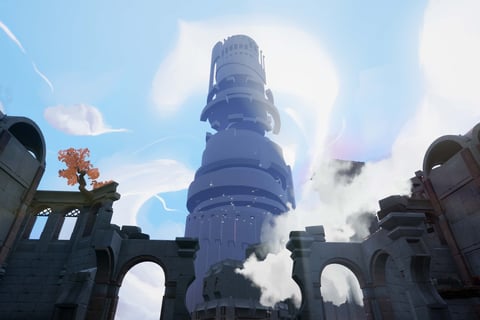



The Main Character
The main protagonist of the game draws inspiration from silent-protagonist, Link, from the Zelda series, as well as the nameless heroes of Journey and Abzu. To minimize technical demands, the character’s face is obscured, eliminating the need for detailed facial animations or stylized hair designs. The final character model was created using a high to low workflow approach, with the claw being separately modeled in low to high subdivisions, allowing for precision and efficiency in the design process.
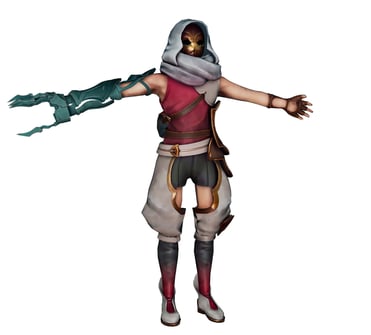

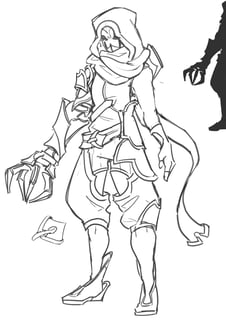

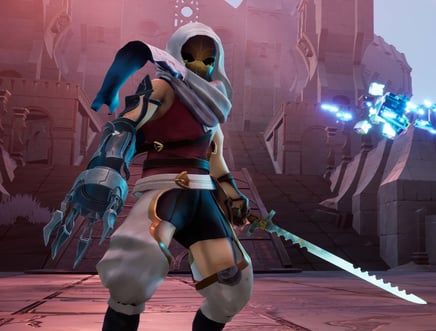

The Companion
The companion serves as the player’s faithful guide throughout their journey and is the one who revives the player at the beginning of the game. Though primarily a narrative element, the companion also plays a crucial role in solving puzzles and alerting the player to important objects in the environment. It is the companion that grants the player their fantastical abilities, serving as the driving force behind their strength and resilience. Design-wise, the companion was modeled after the striking blue bismuth crystals that the player can manipulate within the game. However, unlike the stationary crystals, the companion is a highly kinetic being, designed to showcase its living, breathing nature. Its appearance captures the fantastical essence of the game world, while also emphasizing the companion’s critical role in the player’s overall journey.
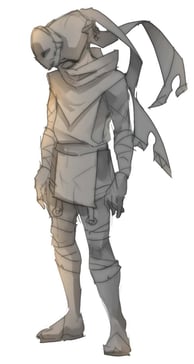

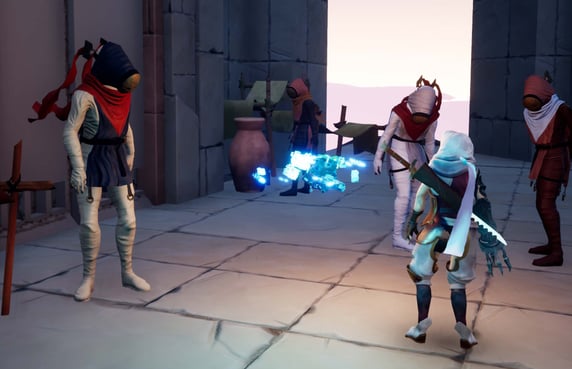

The Cultists
The cultists are enigmatic human characters with ambiguous motivations. They are observed fleeing from the same obstacles as the player and can be found residing in areas of the city that remain unscathed by the collapse. Their visual design is nondescript, with a simple and unadorned appearance. However, their masks, which protrude from their faces, add an eerie and otherworldly quality to their overall look. The use of texture masking and per-instance coloration within the game engine allows for a greater degree of variation among these characters.
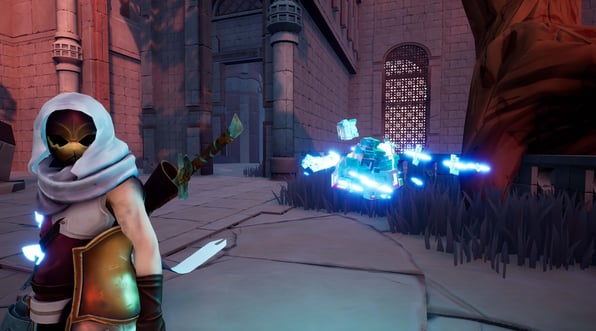

Levels
Level One
The first level of Skystrider is the ancient sky city. This city above the clouds is home to what remains of humanity, and is the player’s place of origin. We want the player to feel awe-struck as they are surrounded by huge, towering skyscrapers erected in stone. To convey the narrative that the player is resurrected in the wake of its collapse, the environment is in a state of ruin, populated with treacherous crumbling architecture. Vibrancy and life is brought back through foliage overgrowth and winding trees that breach the stone walls.
Because the city’s shape language is a balance of both straight and curved edges, the crystal interactables need to stand out. They do so through a strong contrasting cyan color value against the warm-toned city, and are exclusively geometric. The city itself is created using a modular geometry kit for constructing buildings with high-vaulted ceilings, archways, colonnades and other decorative assets to add variation. Small props show how humans lived in the space, and torches still burn to light the player’s way.
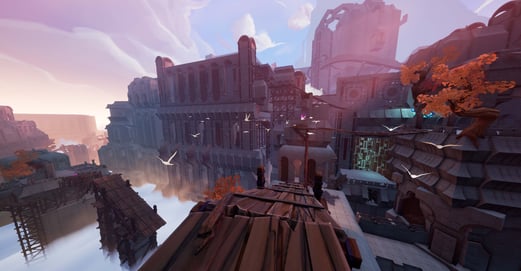

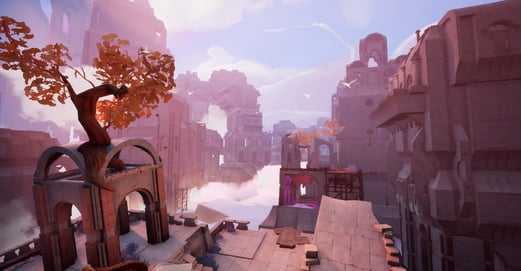

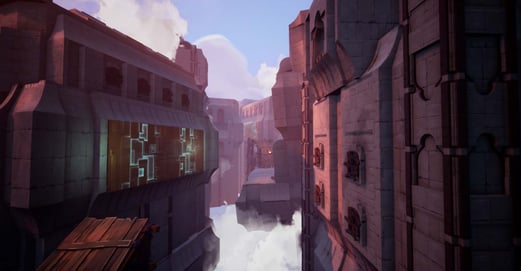

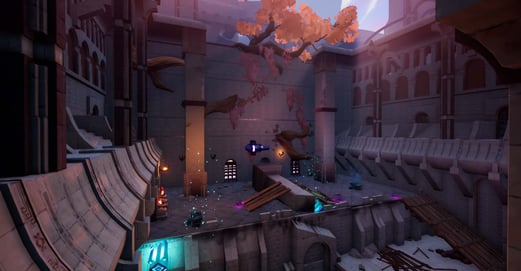

Level Two
The second level is another human-made civilization, now crumbling into the sea. While the sky city has towering architecture, level two’s sunken village is more refined with curves and rounded building styles. Huge whitewashed foundation blocks that would have once supported more sky structures still remain, partially submerged and overgrown.
Many of the architectural pieces seen in this level are the same assets with a different trim sheet texture applied to their material in-engine. A few key visuals such as the torches, railings, and grate patterns are interchanged with designs unique to this level. The foliage asset library accommodates a more unique look in level two, introducing luscious greenery and creating a much cooler-toned palette overall. In many ways this level stands in contrast to the first and should feel totally new to the player. Some sights will feel familiar as they venture closer to the unknown with the Tower now clearly in reach.
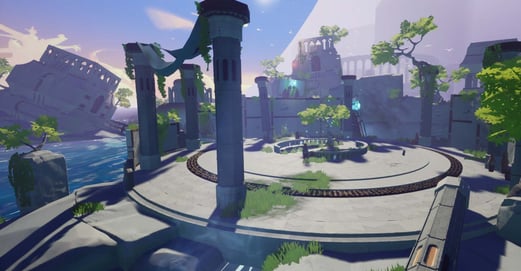

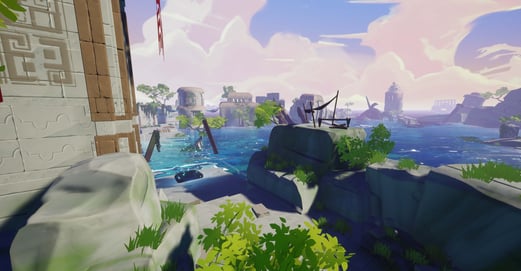


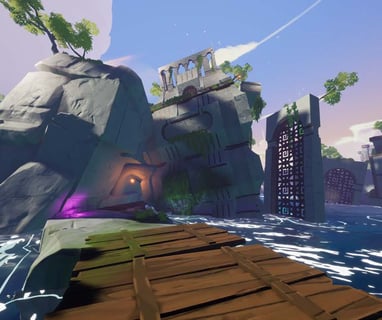
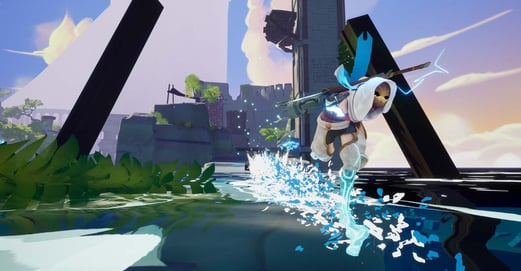

Level Three - UNDER DEVELOPMENT
Level Three thrusts you into the heart of the ancient tower, a technological marvel brimming with futuristic machinery and floating platforms. The sleek, minimalist design of the tower's interior showcases advanced architecture, adorned with metallic structures, and pulsating circuitry. As you navigate up to the top, you'll encounter defense systems, formidable enemies, and new ways to traverse.
Tutorial
The tutorial level serves as a symbolic representation of the resurrection of our protagonist, devoid of any distinct features. The environment is crafted to create an otherworldly, dream-like atmosphere, incorporating fragments from reality. Its primary purpose is to highlight the omnipotent force that has revived the protagonist, entrusting them with its will, and testing their worthiness as it guides the player through this level, limiting their view of what’s in front of them. The level also functions as an instructional guide, familiarizing players with the intricate momentum-based mechanics of movement.
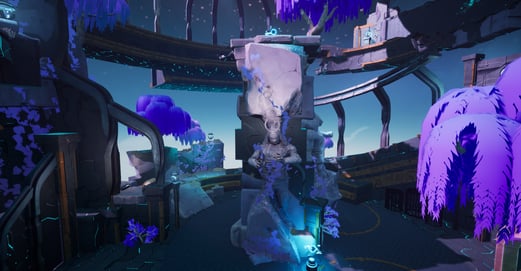

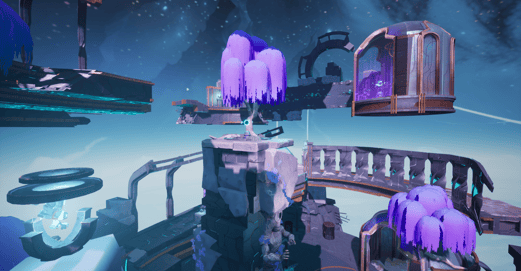

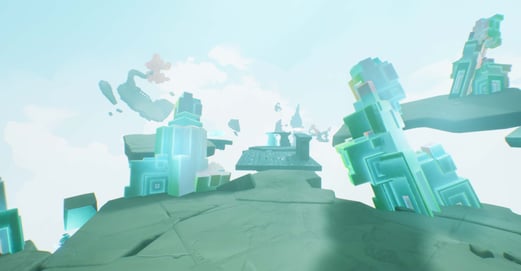

Puzzles and Powerups
Slide Puzzles
The floating bismuth chunks are imbued with a special energy that allows them to be manipulated by the player. The player can drag them around the environment and combine them to create paths that were previously inaccessible. The tower, an ancient structure that exists above the clouds, is responsible for creating these paths and guides the player through the environment. As the player progresses through the game, the puzzles become more complex and require more creative solutions, adding an element of challenge and depth to the gameplay.
Boost Pads
Boost pads are a crucial gameplay element in Skystrider, designed to enhance the player’s movement and agility. Upon activation, boost pads will supercharge the player’s movement, automatically putting them into the overdrive state, allowing them to perform superhuman tasks such as running on water or outrunning exploding crystal traps. Proper utilization of boost pads is essential to navigate through the game’s various obstacles and challenges.
Game Design
Tele Dots
The teleport dots are a unique feature exclusive to the tower. Once inside, the player gains access to old technology that enables them to teleport to specific locations imbued with crystalline energy. These locations are marked by glowing dots that indicate where the player can teleport. The technology used to create these teleportation points is highly advanced and specific to the tower, allowing the player to move through the tower’s various levels quickly and efficiently.
Hazards
Exploding Crystals
Late in the development process, we came up with the idea of exploding crystals to add an extra challenge to the parkour sections. These purple bismuth crystals are shattered and pulsing with kinetic energy, and the slightest movement can trigger a powerful explosion that sends the player soaring through the air. This mechanic forces the player to react quickly and maintain their momentum in order to navigate the environment successfully.
Poison Puddles
To further expand on the idea behind the crystals, they are a vital energy resource in the world of Skystrider, and when depleted they become these corrupted purple crystals that can be triggered to explode. However, when the crystals are completely drained of their energy, they transform into a hazardous purple sludge that is dangerous for the player to touch. Despite its danger, the sludge does not affect the player’s momentum, allowing them to continue their parkour sequences uninterrupted. This mechanic adds an additional layer of challenge for the player to navigate through while exploring the world of Skystrider.




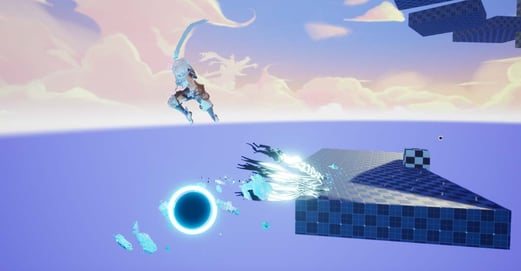

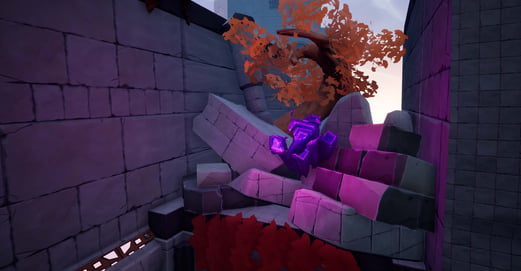


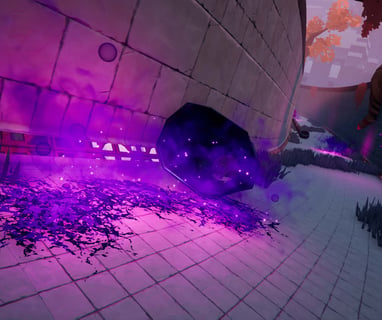
The Player
Breakdown
The Player controller of skystrider is the by far the most complex element in the game. The three main pillars of the player are parkour, combat, and the claw. all of these have to work seamlessly between each other seamlessly or the whole fantasy we are trying to build is destroyed.
Parkour
The parkour system is built on a fine tuned base movement component that responds to various conditions to change its speed, jump height, and other micro adjustment layers. The system is built on building momentum and the easiest way to do that is to either run down an incline or boost. once momentum has been created it then can be maintained by completing conditions that either build momentum or conserve it. This momentum is then either transferred into abilities with the players overcharge attack, or into longer wall runs and boost pad uses. During basic movement the player is constantly moving in and out of different movement states this helps sell the fantasy that you are an agile worrier parkouring and wall running through a ruined world.
Combat
For the combat system, the main considerations were keeping the combat straightforward input wise, but with many options based on the context of what you are doing at any given moment, and what you interact with. One of the main systems in place is a soft-targeting/homing system, eschewing the need for a full lock-on. One of the main tools the player has is the ability to equip and throw various objects. Once you attempt to throw an object, the game takes into account the amount of time you spent charging up the toss, and adds more force (and a faster throw) accordingly.
The Claw
The Claw is the main mode of interaction the player has with the world. Using a homing and targeting system the player can quickly select interactable objects and use their input to control or activate certain devices. In conjunction with parkour this becomes a timing tool for creating platforms just at the right time, or attacking enemies that are out of each.
Player Showcase
Enemies
The Sentinels
The sentinels in the game are a deadly army of constructs created by the tower with the sole purpose of eradicating all life. These soulless beings are ruthless and unrelenting in their killing pursuits, and they carry a single sword or a sword and shield made from the equipment of their fallen foes. Each sentinel bears the signature mark of the tower on their chests, marking them as its agents
They are slower enemies with high health and are the most common enemy type in the game. These formidable foes work together to take down the player, using their shield-bearing counterparts to protect themselves from incoming attacks. Players can rip the shields off of shielded sentinels and use them as a weapon to deal even more damage. The sentinels are a dangerous opponent and present a significant challenge for players. Their design and combat mechanics are both engaging and satisfying, making them a thrilling enemy to face off against.

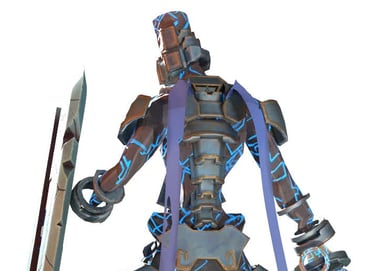

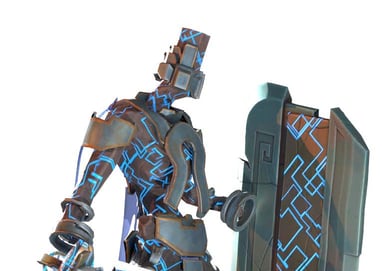
Turret
The turrets are powerful, cannon-like weapons that are strategically placed throughout the game’s arenas and parkour sections as an additional hazard to the player. These automated weapons are capable of firing at a high rate and can deal significant damage to the player if left unchecked. They are often mounted on walls or ceilings and can swivel to track the player’s movements, making them a constant threat. Dodging their attacks or finding ways to disable them is crucial to progressing through these challenging areas. The turrets’ design is sleek and futuristic yet still calls on classical feeling designs, fitting in with the game’s overall aesthetic while adding a sense of danger and urgency to the player’s journey.
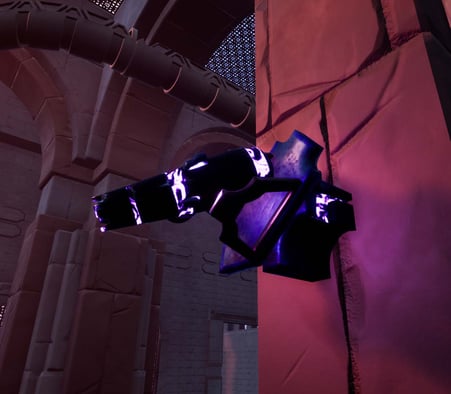



Arachdroid
The Arachdroid is a long-range enemy that can quickly boost itself into the air, allowing it to reach advantageous locations and launch projectiles at the player. Each projectile has a unique status effect, such as explosive damage, poison puddles, or the ability to launch explosive cores. These attacks require players to stay vigilant and react quickly to avoid taking damage. When designing the Arachdroids and flyers, the game development team carefully considered player movement and mobility. These enemies are highly mobile, and pose a significant threat if not dealt with swiftly.
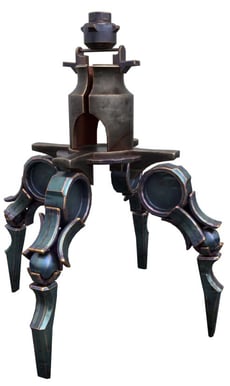

The Flyer
the flyer is an airborne enemy that relies on its speed and spacing to attack the player. While it has the lowest health out of all the enemies, its high damage potential makes it a formidable foe. Players must be mindful of the flyer’s movements and position themselves accordingly to avoid taking significant damage.
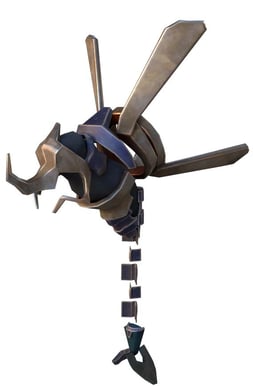

Golem
The golem is a small, yet formidable enemy that floats menacingly and is usually found in groups. Their design is based on a combination of stone and tower technology, giving them a rugged and menacing appearance. They relentlessly charge the player, exploding upon impact to knock them back and deal significant damage. Their sole purpose is destruction and they will stop at nothing to eliminate any perceived threats. Despite their size, they are a force to be reckoned with and require quick reflexes and strategic planning to defeat.
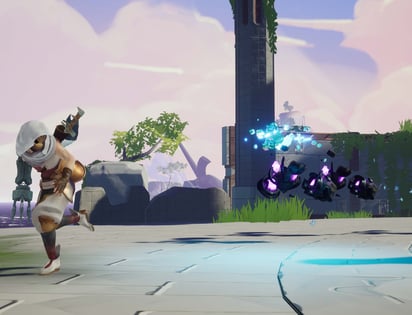

Explosive Core
This is an equippable weapon that the player can find around the level. It is old tech that holds a vast amount of kinetic energy, the player can throw the core and deal massive amounts of damage.


The Drone
The drone is a versatile enemy and worker of the tower that is equipped with the ability to fly and transport goods or enemies, as well as being outfitted with deadly weaponry. In transport mode, the drone features a cage that drops enemies into battle, making fights even more unpredictable and challenging for the player. During combat, the drone is armed with a rapid-fire turret and a gravity disruption device that sends out massive shock waves, dealing significant damage to the player unless they boost over the impact waves. The drone’s design is similar to other robotic enemies in the game, featuring the same armor and color palette, but with the addition of propellers that allow it to hover above the ground. This hover motion gives the drone a very dynamic appearance and allows it to respond to attacks and terrain in a fluid and engaging way.
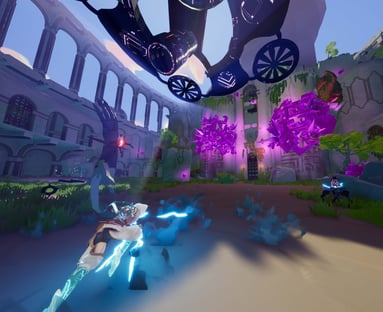

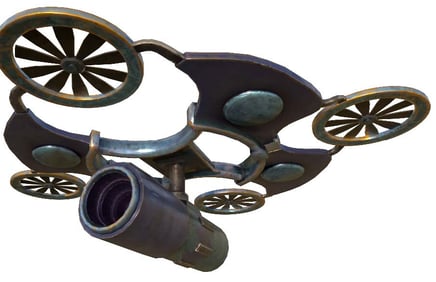

Level One Tower Boss
Our first boss is a colossal, large titan. The most distinct features are their hands, both on their wrists and at the center of their chest. For our boss fight design, it was important to incorporate these into the fight, especially using their very hands and fingers as weapons. Players will have to utilize their knowledge of using their environment to defeat it, while dodging a plethora of escalating attacks as the fight progresses. The level one boss was designed to be intimidating, with hard-surface armor, and connected to the other sentinels. We chose “hands” as the main motif keeping in mind that the figure should work in harmony with the Tower’s main statue to represent the Tower as the deity in the eyes of its worshipers. As opposed to making a humanoid equipped with heavy armor, they are assembled from armor pieces. As soon as the original sketches felt correct, we translated them into three dimensional space, incorporating the hole in its chest for its battle gameplay, and adding spikes to evoke even more danger. The equippable fingers serve as weapons since we use projectiles as a kind of attack mechanic. While keeping the consistency of the style, aesthetics, and fantasy functionality in mind, we completed passes of ideation and sketches so that the art director and the team could determine what they would want to see. We chose to narrow the intermediate phalanges and extend the fingernails to accentuate a longer and more threatening silhouette.
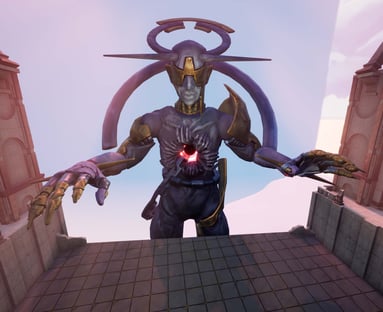

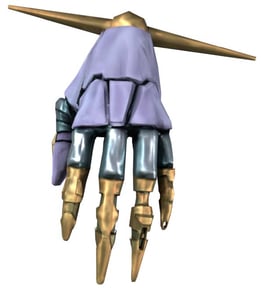


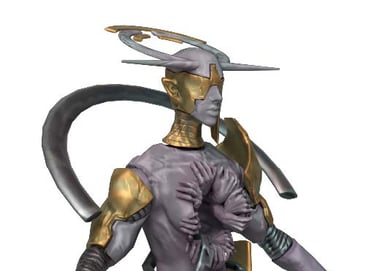
VFX
About The VFX
VFX is often seen as a supportive aspect that adds that needed flare to interactions and the world to give impact and life to the many visual cues a game needs. For our world, the VFX becomes a defining factor to the visuals, often not just remaining the support but becoming the center piece itself.
Bismuth crystals and the language of “Creation, Destruction, and Manipulation” became the core to VFX, keeping in line with the greater themes of the game and it’s narrative. The feeling that these crystals and other unique visual aspects are unwieldy and barely controllable define a unique relationship between the player and the world, looking to give the player the feeling of power but only a taste in the face of the greater power of the tower.
Another key role to the VFX is being a thematic bridge between our very special blend of sci-fi and ancient fantasy. Diligent usage of emissives, particles, and crystals across the board for enemies, interactions, and puzzles allows for a unity between the various artists’ interpretations of our world.
VFX Showcase
Technical Pipeline and Tools
About Optimization
Optimization is an essential aspect of game development that should not be overlooked, especially when creating a video game with a large and detailed world, like the one featured in this art book. The optimization process involves maximizing the game’s performance and minimizing any potential issues or bugs that could negatively impact the player’s experience. This is particularly important for artists and designers, who rely on the game engine’s ability to render high-quality graphics and intricate details while maintaining a smooth gameplay experience. By optimizing the game, artists can ensure that their vision is faithfully brought to life in the game, while also creating a more enjoyable and immersive experience for the players.
Character Optimization
Character models are heavily optimized to achieve a desired frame rate on more limited platforms. They are primarily modeled high-to-low with baked normal mapping for their high-resolution detail. The main player character for example is comparable in tri-count to Link’s model in Breath of the Wild at less than 10k tris. All character models in the game use only one texture set each, and any additional VFX or emissive masking is achieved through custom masks and shaders in the engine.
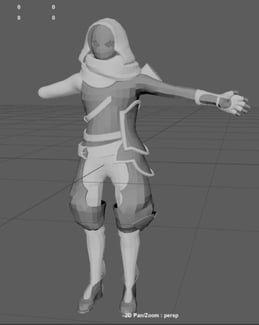

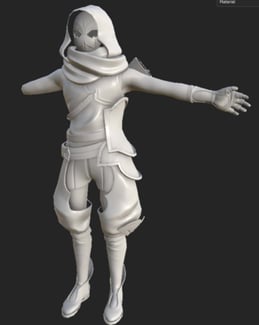

Trim Sheet
Trim sheets are an essential tool for game developers to optimize their workflow and reduce asset creation time. By creating a single texture sheet that contains multiple smaller textures, artists can easily reuse common elements throughout the game without having to recreate them from scratch each time. This not only saves time but also reduces the overall size of the game’s asset library, leading to faster load times and improved performance. Furthermore, trim sheets also help developers to maintain a consistent art style throughout the game, as they can easily reuse the same assets across different levels and environments.
In skystrider, we utilized trim sheets extensively for all of our architectural assets. This allowed us to easily create buildings and structures with standardized textures and easily add auxiliary details. By using the same textures across multiple assets, we were able to achieve a cohesive look and feel for the entire game world. Trim sheets also helped us to quickly prototype new assets and iterate on them as needed. For example, if we needed to change the color or design of a certain texture, we could do so easily within the trim sheet, and all assets using that texture would update automatically.


Level Streaming
As game developers, level streaming is an essential technique that we rely on to create the immersive and complex environments in the game featured in this art book. It allows us to create larger and more intricate game environments without sacrificing the game’s performance or visual quality. By dynamically loading and unloading game levels as the player progresses through the game, we can significantly reduce the game’s memory usage and processing power requirements, resulting in a smoother and more seamless gameplay experience. This technique is particularly useful for games with vast and detailed worlds, as it allows us to create more content while minimizing the performance impact on the game. As artists and designers, level streaming also gives us the freedom to create unique and complex environments that seamlessly blend together, providing an immersive and engaging experience for the player. In the end, level streaming is a critical tool in our game development toolkit, enabling us to create the game world we envisioned while delivering an optimal gameplay experience for our players.

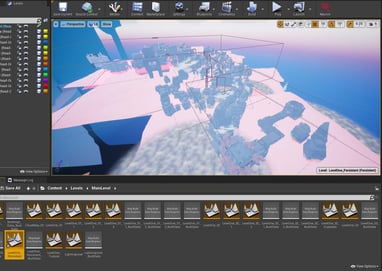
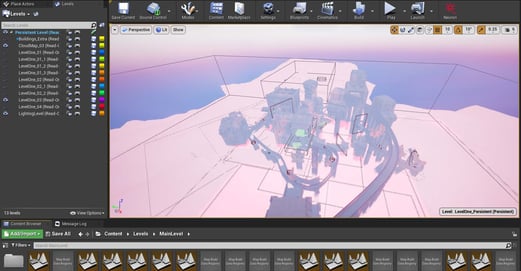

Engine Tools
During the development of this game, we quickly realized that relying solely on the stock tools provided by Unreal Engine was not enough to achieve our vision for the game. As a result, we devoted a significant amount of time to developing various tools to streamline our workflow and improve our pipeline. At the editor level, we expanded the functionality of the editor to include custom actions that accelerate our workflow, such as auto collision and auto LOD tools. These tools automate tasks that would otherwise be time-consuming and tedious, allowing us to focus on the creative aspects of the game development process. Additionally, by creating our own tools, we were able to tailor them specifically to our needs, ensuring that they were optimized for the game’s unique requirements. This investment in developing custom tools has proven to be invaluable, as it has allowed us to create a game world that is rich in detail and complexity while maintaining an efficient development process.
Procedural Aqueduct Builder
One of the standout tools we developed for this game is the Procedural Aqueduct Builder, which was initially designed for use in level one but has since become an essential asset in level two as well. This powerful tool allows us to create complex parkour sections out of an aqueduct kit, streamlining the level design process and enhancing the player’s experience. The Procedural Aqueduct Builder comes equipped with a variety of features, including support for broken sections, dynamic support height, and the ability to manipulate complex meshes using splines. These features allow us to create unique and intricate aqueduct structures that would have been impossible to achieve manually, and enable us to offer players an engaging and challenging parkour experience that fits seamlessly into the game world.


In-Engine Decal Creator ( For more info Visit the breakdown Here )
Another tool that we developed for this game is the Decal Creator, which enables us to create complex decals using only noise texture inputs. This tool was born out of the necessity to avoid repetition in our game world, as we had a significant number of tiling architectural pieces that could easily become monotonous if not carefully managed. The Decal Creator tool allows artists to create thousands of unique-looking decals with ease, using various settings that can be tweaked to achieve the desired effect. One of the benefits of the Decal Creator tool is that it allows us to achieve a high degree of detail and complexity in our game world without sacrificing performance. By generating decals procedurally, we can minimize the amount of memory and processing power required to render them, ensuring that the game runs smoothly on a wide range of hardware configurations. This also makes it easier to iterate on the game’s design, as artists can experiment with different settings and generate new decals quickly and efficiently.
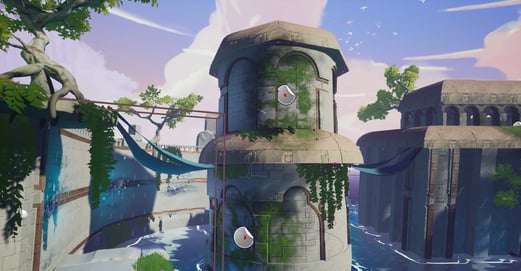

Prop Scatter Tool
One of our most frequently used tools in level design is the Prop Scatter tool, which has proven to be invaluable in populating large areas with debris and clutter. This tool allows us to specify a zone that we want to be populated, and the scatter tool will randomly scatter objects in that area. These objects are aligned to the surface, ensuring that they look natural and fit seamlessly into the environment. Additionally, the Prop Scatter tool randomizes various attributes of the objects, further enhancing the realism of the scene. Moreover, our complex animation system allows the scattered objects to affect our Inverse Kinematics (IK) system without affecting the player’s actual collision. This means that the scattered objects can move and react naturally, without disrupting the player’s movement or causing glitches in the game. This feature is critical to maintaining the immersion of the game world, as it ensures that the environment responds dynamically to the player’s actions, making the experience more engaging and realistic.
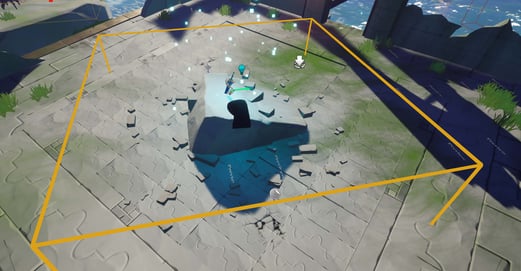

Mesh Manipulators
As a small team of developers working on a large game world with complex architecture, we faced a daunting task when it came to populating the world with believable structures. To overcome this challenge, we developed a handful of tools that have proven to be essential in our workflow. The Array tool, for example, allows us to quickly create repeating structures with ease. This tool has been invaluable in creating complex structures with intricate details, as it streamlines the process of creating repeating elements and saves us valuable time in the development process. We also developed custom spline mesh tools, such as the Railing Spline and Wall Spline tools, that allow us to create varied railings and walls with ease. These tools enable us to specify start and end points for the spline, as well as randomizing the destruction level of the final mesh. This helps us create believable, realistic structures that add depth and complexity to the game world. Another tool we developed is the Circular Spline tool, which has proven to be indispensable in level two, where circular structures abound. This simple tool allows us to create perfect circles quickly and efficiently, enabling us to create complex structures with ease.
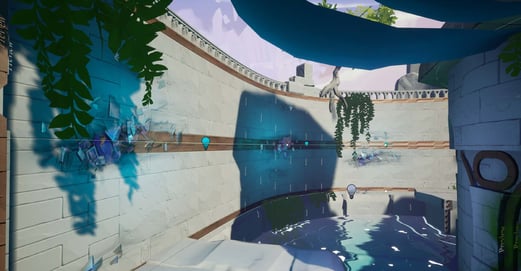

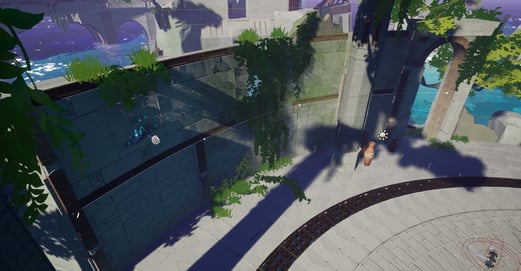

Lost Ideas
About The process
The inception of Skystrider was characterized by a distinct approach that deviated from its current iteration. Initially, the game was conceptualized as a boss rush game that required players to navigate vast environments by solving puzzles and engaging in sporadic combat to confront a major boss. Our aim was to develop bosses that presented intricate challenges rather than straightforward fights. However, after investing a significant ten-week period into its construction, it became evident that the expansive environments did not optimally accommodate the players’ character movements, providing minimal excitement for the player. Subsequently, we arrived at the conclusion that more linear environments would be better suited for the game’s mechanics.
Our movement system underwent a gradual evolution, transitioning from a grapple mechanic that initially pulled the player forward, to a more advanced version that launched the player forward, and finally culminating in an air boost ability that propels the player through the air.
The game’s enemy design underwent significant alterations during the development phase. Originally, the boss encounters numbered five, each tied to a particular environment that was representative of distinct biomes. At the game’s inception, we dismissed the possibility of featuring enemies that were smaller than the player, and we heavily leaned towards incorporating creatures over humanoid opponents. However, as the development process unfolded, our perspective on this matter gradually shifted. At present, we have struck a balance between featuring both humanoid and creature-based enemies that are scaled appropriately to the player’s size, except for the bosses, which remain larger than the average enemy. Consequently, the game offers a more diversified and captivating enemy experience for the player.
